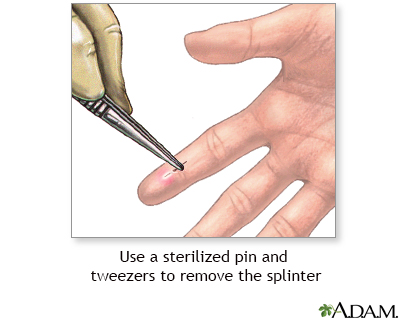Splinter removal
 Print-Friendly
Print-Friendly
A splinter is a thin piece of material (such as wood, glass, or metal) that gets embedded just below the top layer of your skin.
To remove a splinter, first wash your hands with soap and water. Use tweezers to grab the splinter. Carefully pull it out at the same angle it went in.
If the splinter is under the skin or hard to grab:
- Sterilize a pin or needle by soaking it in rubbing alcohol or placing the tip in a flame.
- Wash your hands with soap.
- Use the pin to gently remove skin over the splinter.
- Then use the tip of the pin to lift the end of the splinter out.
- You may need to use tweezers to pull out the splinter after you lift it.
After the splinter is out, wash the area with soap and water. Pat the area dry. (Don't rub.) Bandage the cut if it is likely to get dirty.
See your health care provider if there is inflammation or pus, or if the splinter is deeply embedded. Also seek medical attention if the splinter is in your eye or close to it.
I Would Like to Learn About:
Information
To remove a splinter, first wash your hands with soap and water. Use tweezers to grab the splinter. Carefully pull it out at the same angle it went in.
If the splinter is under the skin or hard to grab:
- Sterilize a pin or needle by soaking it in rubbing alcohol or placing the tip in a flame.
- Wash your hands with soap.
- Use the pin to gently remove skin over the splinter.
- Then use the tip of the pin to lift the end of the splinter out.
- You may need to use tweezers to pull out the splinter after you lift it.
After the splinter is out, wash the area with soap and water. Pat the area dry. (Don't rub.) Bandage the cut if it is likely to get dirty.
See your health care provider if there is inflammation or pus, or if the splinter is deeply embedded. Also seek medical attention if the splinter is in your eye or close to it.
Related Information
References
Higgins T. Procedures. In: Higgins T, Arastu AS, Auerbach PS, eds. Medicine for the Outdoors: The Essential Guide to First Aid and Medical Emergencies. 7th ed. Philadelphia, PA: Elsevier; 2024:469-477.
Stone DB, Scordino DJ. Foreign body removal. In: Roberts JR, Custalow CB, Thomsen TW, eds. Roberts and Hedges' Clinical Procedures in Emergency Medicine and Acute Care. 7th ed. Philadelphia, PA: Elsevier; 2019:chap 36.




